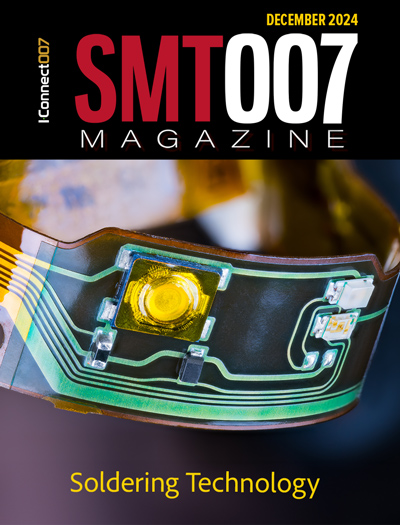-

- News
- Books
Featured Books
- smt007 Magazine
Latest Issues
Current Issue
The Path Ahead
What are you paying the most attention to as we enter 2025? Find out what we learned when we asked that question. Join us as we explore five main themes in the new year.

Soldering Technologies
Soldering is the heartbeat of assembly, and new developments are taking place to match the rest of the innovation in electronics. There are tried-and-true technologies for soldering. But new challenges in packaging, materials, and sustainability may be putting this key step in flux.

The Rise of Data
Analytics is a given in this industry, but the threshold is changing. If you think you're too small to invest in analytics, you may need to reconsider. So how do you do analytics better? What are the new tools, and how do you get started?
- Articles
- Columns
Search Console
- Links
- Media kit
||| MENU - smt007 Magazine
Some Fundamentals of Tin-Bismuth Metallurgy and Electromigration
September 24, 2024 | Prabjit Singh, Raiyo Aspandiar, Haley Fu, and L. A. SwaminathanEstimated reading time: 1 minute
Near-eutectic tin-bismuth alloy is a strong contender as the solder of choice for low-temperature electronic assembly applications. This article will describe the recent significant developments by the iNEMI project team on the understanding of the electromigration behavior of Sn-Bi solder which has a unique physical metallurgy and electromigration behavior quite different for that of Sn-Ag-Cu (SAC) solder and other solders in common use today.
The high rate of Bi electromigration and its high homologous temperature sets the near-eutectic Sn-Bi solder apart from the SAC and the Pb-Sn solders. The latter have lower homologous temperatures and have no one element dominating the electromigration phenomenon that can be readily tracked to monitor their electromigration behavior.
In Sn-Bi alloys, the rates of Bi electromigration are clearly reflected in the rates of electrical resistance increase, making it more convenient to use the fundamental physics-based electromigration equations rather than Black’s somewhat empirical equation that deals with the mean time to failure of solder joints. The high homologous temperature of Sn-Bi alloys makes in-situ study of electromigration in a scanning electron microscope more convenient, resulting in a much deeper understanding of the physical metallurgy and electromigration of the Sn-Bi alloys.
For example, recent in-situ studies have shown that the root cause of decreasing solder electrical resistance in the early stage of electromigration, very evident at low temperatures and low current densities, is due to the microstructural coarsening of the alloy. This paper will review the recent research by the iNEMI project team on Sn-Bi electromigration justifying a more physics-based study of the solder alloy. When results are summarized on Arrhenius plots, the prediction of electromigration life under any give field condition becomes straightforward.
To read this entire article, which appeared in the September 2024 issue of SMT007 Magazine, click here.
Suggested Items
iNEMI LTS Tech Topic Series: Electromigration in Tin-Bismuth Planar Solder Joints
10/10/2023 | iNEMIiNEMI is launching a series of webinars focused on low temperature solder (LTS). This first webinar in the series will share information from Phase 1 of iNEMI’s Electromigration in SnBi Solder for Second-Level Interconnect project, which is determining the effects of joint height, temperature, current density and PCB finishes on reliability over a product’s life.
Call-for-Participation Webinar: iNEMI Electromigration of SnBi Solder for Second-Level Interconnect Project
01/07/2022 | iNEMIThe low melting temperature of SnBi alloys (138°C) makes them attractive for assembling thermally warpage-prone high-density microelectronic packaging.
Ansys Receives TSMC OIP Ecosystem Forum Customers' Choice Award for 5G Millimeter Wave Chip Analysis Solution Paper
03/19/2021 | PRNewswireAnsys received the Customers' Choice Award for a technical paper presented at TSMC 2020 North America Open Innovation Platform® (OIP) Ecosystem Forum.


